It’s absolutely no surprise that six of the ten most popular Italian dishes in the UK are, in fact, pasta based. Having been eaten for hundreds of years, pasta has also become a staple of British kitchens. From easy weeknight dinners to dishes showcasing slow-cooked sauces, these are the best pasta recipes.
Best pasta recipes
Homemade Pasta
Although there’s absolutely nothing wrong with dried pasta, this fresh pasta recipe is a great starting point. What’s more, it doesn’t require a pasta roller or any specialist equipment.
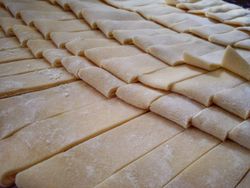
Homemade pasta, without a pasta machine
Equipment
- Rolling Pin
Ingredients
- 600 g tipo ’00’ flour plus extra for dusting
- 6 large eggs ideally free-range
- Salt to taste
- Extra virgin olive oil a drizzle, to taste
Instructions
- Pour the flour onto a large, clean surface and make a well in the middle. Crack the eggs into the well, followed by a pinch of salt and a drizzle of extra virgin olive oil. Beat the eggs with a fork, gradually pulling the flour into the well in the centre.
- Once the eggs and flour mixture becomes too firm to mix with a fork, dust your hands with flour, bring all of the flour to the centre, and knead for at least ten minutes until well combined, with the consistency of Play-Doh.
- Wrap the dough in cling film, squeezing all of the air out, and leave to sit for thirty minutes at room temperature to allow the gluten to relax.
- Unwrap the dough and dust with flour. Also dust your hands, the countertop, and rolling pin with flour. Cut the dough into manageable sized pieces (into two or four pieces dependent on size) and begin to gently roll out with a rolling pin.
- To laminate, fold the piece of partially rolled dough into three, lengthwise, rotate 90 degrees and continue rolling. Do this three times before rolling out completely, as thinly and evenly as possible.
- Cut the dough into your desired shape then dust each piece with more flour, to prevent them from sticking to each other while storing or cooking. Hang to dry or place under a sheet of cling film until ready to use.
- Remember, fresh pasta cooks far more quickly than dried pasta. Fresh pappardelle, for instance, will take around 90 seconds to two minutes to cook.
Spaghetti & Meatballs
An Italian-American classic, these meatballs are made with a blend of beef, pork, and veal mince, finished in a rich tomato sauce.
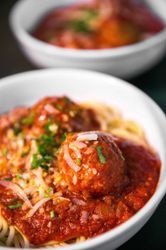
Spaghetti and Meatballs
Ingredients
- 1 large onion finely chopped
- A pinch salt
- 1 tsp chilli flakes
- Small bunch basil stalks chopped, leaves ripped
- 4 cloves garlic finely sliced
- 150 ml red wine
- 3 x 400g tins peeled tomatoes
- 1 tsp dried oregano
- 2 tsp white sugar
- 500 g spaghetti or your pasta of choice
- 100 g butter
- 100 g parmesan
- Freshly ground black pepper
For the meatballs
- 200 g beef mince
- 200 g pork mince
- 100 g veal mince if you can’t find veal mince, an equal mixture of pork and beef will work fine – or just 500g of one meat
- 1 tsp dried basil
- 1 tsp dried oregano
- 1 tsp dried sage
- 1 tsp dried marjoram
- 1 tsp dried thyme
- 1 tsp dried rosemary
- ½ tsp sugar
- 1 tsp paprika
- 1 tsp grated nutmeg
- 2 tbsp grated parmesan
- 1 egg
- A pinch salt
Instructions
- Cover the base of a large sauce pan with olive oil and heat for 30 seconds, until shimmering. Add the finely chopped onion to the pan and stir. Season with a pinch of salt, decrease the heat to low, cover the onions and cook for around 10 minutes, stirring often.
- Once the onions are soft and translucent, add the chilli flakes, basil stalks, and finely sliced garlic to the pan. Increase the heat and cook for one minute. Keep stirring to prevent the garlic from burning.
- Add the red wine to the pan and stir. Cook for another five minutes or so, until the wine has reduced by 2/3.
- Once the wine has reduced, add the tomatoes to the pan. Fill one of the empty tins with water and add that to the pan, too. Throw half the ripped basil leaves, oregano, and 2 teaspoons white sugar into the pan and slowly bring to the boil.
- When the sauce begins to boil, decrease the heat and cook slowly, stirring occasionally to prevent it from catching.
- While the sauce cooks, combine the meatball mixture in a mixing bowl and separate into approximately 25-30 meatballs, dependent on size preference.
- Heat a little oil in a frying pan and gently fry the meatballs until firm when pinched with cooking tongs. Cook the meatballs in batches if necessary, to avoid overcrowding the pan.
- Once fried, add the meatballs to the sauce and continue to cook over low heat for at least 10 minutes.
- After adding the meatballs to the sauce, cook the pasta according to packet instructions (or for 2-3 minutes if using fresh) until al dente. Reserve the cooking water.
- Once cooked al dente, transfer the pasta to the pan with the meatballs and sauce. Add a ladle or two of cooking water, the butter, most of the parmesan, and the remaining basil leaves. Stir to combine, continuing to cook over low heat. Once the butter and cheese have melted, transfer the spaghetti and meatballs to a bowl and finish with an additional sprinkle of parmesan, plus a crack of black pepper.
Lasagne
Instead of using béchamel, this lasagne recipe favours three different cheeses and a ragù cooked for three-to-four hours, featuring beef mince, veal mince, and sweet Italian pork sausage, with pasta sheets, ricotta, fresh mozzarella slices, and a good amount of Parmigiano Reggiano.

Ragù Alla Bolognese
A meat-based sauce often confused with spaghetti Bolognese, this ragù alla Bolognese is made using slow-cooked minced beef and pork, white wine, cream, and just a touch of tomato, served with al dente tagliatelle pasta and dressed with fistfuls of grated Parmigiano Reggiano.

Ragù alla Bolognese
Equipment
- Large, heavy-based saucepan
Ingredients
- 1 large onion finely chopped
- 2 medium carrots peeled and finely chopped
- 2 sticks celery finely chopped
- 600 g minced beef
- 300 g minced pork
- 200 g pancetta or smoked streaky bacon cut into lardons
- 50 g tomato puree
- 1 litre beef stock
- 200 ml white wine
- 125 ml double cream or milk
- 2 bay leaves
- 750 g tagliatelle pasta
- Parmigiano Reggiano to taste
- Olive oil
- Sea salt
- Freshly ground black pepper
Instructions
- Heat a drizzle of olive oil in a large, heavy-based pan until shimmering and add the beef. Cook on medium-high heat, stirring occasionally and breaking up with a spoon. Once lightly browned (3-5 minutes), remove the beef from the pan and set aside. Repeat the process with the minced pork. Once the pork is browned, set aside.
- In a separate pan, cook the pancetta over low-medium heat until golden.
- Meanwhile, add the onion, carrot and celery to the large saucepan used to brown the meat and sauté until soft, adding more oil if necessary.
- Slightly drain the pancetta to remove excess fat (but save the rendered fat for another recipe) and add to the pan with the onions, carrot and celery. Increase the heat, then season with a pinch of salt and add the tomato puree. Stir to combine.
- Cook the tomato puree for a minute or two, then pour in the red wine to deglaze. Make sure to scrape all the frond from the bottom of the pan. Simmer for five minutes or so, until the wine has almost completely evaporated.
- Return the browned beef and pork to the pan, followed by the beef stock. There should be just enough stock to submerge all of the ingredients in the pan. Add the bay leaves, stir to combine, then bring to the boil and gently simmer for 2-3 hours, stirring occasionally and adding more liquid if need be.
- Pour the cream or milk into the pan and stir to combine. Cover with a lid slightly ajar and simmer, stirring occasionally, for another 45 minutes.
- Once the ragù is almost ready, remove the bay leaves and cook the pasta until approximately 2 minutes before fully cooked. Add the pasta to the pan with the ragù alongside a ladleful of the pasta’s cooking water, increase the heat to high, then stir to quickly incorporate.
- Serve with grated cheese, such as Parmigiano Reggiano and a crack of freshly ground pepper.
Multi-coloured Ravioli with Butter & Sage
Italian chef Danilo Cortellini’s adapted multi-coloured ravioli with butter and sage is particularly impressive and fairly simple to make at home, featuring pasta shells filled with ricotta.
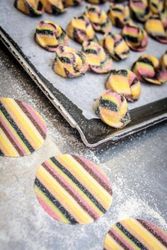
Multi-coloured Ravioli with Butter & Sage
Ingredients
- 400 g Fresh ricotta
- 50 g Unsalted butter
- Sage 1 small bunch
- 60 g Grana Padano cheese grated
- Salt and pepper, to taste
For the Yellow Pasta
- 2 Fresh Italian yellow eggs (they have a deeper colour)
- 200 g 00 flour
For the Green Pasta
- Parsley 1 small bunch
- 2 Fresh eggs
- 200 g 00 flour
For the Pink Pasta
- 2 Fresh eggs
- 20 g Cooked beetroot
- 1 tsp Beetroot juice
- 240 g 00 flour
Instructions
To Make the Yellow Pasta
- Knead the egg with the flour until it makes a smooth and elastic dough. You only reach the right consistency if the pasta has been worked hard enough to allow the gluten molecules to break down; the dough’s elasticity is very important for the final result.
- Wrap in cling film and let it rest for 30 minutes.
To Make the Green Pasta
- Blanch the parsley leaves in salted boiling water then cool in iced water to retain their colour.
- Blend the cooked parsley with eggs and knead the egg mixture with the flour until smooth and elastic. It should have the same consistency as the yellow pasta.
- Wrap in cling film and let it rest for 30 minutes.
To Make the Pink Pasta
- Blend the beetroot well with the beetroot juice and the egg.
- Knead the pink egg mixture with the 00 flour until elastic and smooth. If a pasta is too dry, add a bit of egg. If the pasta is too wet, add a little flour.
- Wrap in cling film and let it rest for 30 minutes.
- Roll out 3 sheets of the same thickness through the pasta machine for each colour. The thickness of the sheet will correspond to the thickness of the coloured stripe.
- Once all the pasta doughs have been rolled out, proceed to stack the coloured sheets on top of each other. Make sure that there is no flour caught between the layers.
- Cut the layered block in half and stack the second half on top of the first block. This process can be repeated if necessary.
- Wrap the block in cling film and let it rest in the fridge for approximately 4-5 hours.
- To obtain a beautiful striped ravioli, cut a thin slice of pasta from the block. Roll it out lengthways once or twice through the pasta machine: the stripes should be perpendicular to the pasta machine.
- Following this procedure, you can create all sorts of beautiful shaped pasta.
To Assemble
- Roll the pasta very thin, cut 8cm diameter ring and place a spoon full of ricotta in each ring, brush the edge with water. Fold it and pinch the edges.
- Boil the ravioli in salted water for a couple of minutes.
- In another pan melt the butter with a pinch of salt and add the sage.
- Drain the ravioli directly in the pan and add a ladle full of cooking water, dress with Grana Padano and serve.
Wild Mushroom & Truffle Macaroni Cheese
A decadent vegetarian dish, this macaroni cheese recipe is spiked with earthy wild mushrooms and black truffle, finished with a scoop of truffle crème fraîche.

Wild Mushroom & Truffle Macaroni Cheese
Ingredients
- 70 gram Wild mushroom mix sautéed
- 160 gram Rigatoni pasta blanched
- 140 gram Cheese sauce (recipe below)
- 25 gram Truffle crème fraîche (recipe below)
- Truffle oil
For the cheese sauce
- 100 gram Flour
- 100 gram Butter
- 1300 ml Milk
- 170 gram Mild cheddar grated
- 1 – 2 tbsp Mustard
For the truffle crème fraîche
- 1 tbsp Black truffle paste
- 1 tbsp Truffle oil
- 50 gram Crème fraîche
- 50 gram Mascarpone cheese
- 85 gram Double cream whipped
Instructions
- Cook the rigatoni in hot boiling salted water until al dente, then refresh in cold water
- For the cheese sauce, make as a béchamel sauce, then add the grated cheese and cook out until melted
- To make the truffle crème fraîche, add all the ingredients except the cream together
- Mix evenly then fold in the whipped cream and season to taste
- Heat the cooked mushrooms in a pan with the cheese sauce and a splash of truffle oil
- Once hot, toss the pasta through the mixture then serve with a scoop of truffle crème fraîche on top
Spaghetti Alla Nerano
A pasta dish invented in the Amalfi Coast town of Nerano, Spaghetti Alla Nerano is traditionally made with fried courgette, spaghetti, and provolone del Monaco. Given the cheese’s rarity in the UK, however, a blend of Parmigiano Reggiano and Pecorino Romano can be used as a suitable alternative.
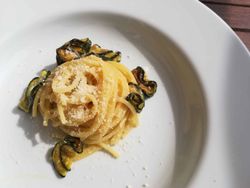
Spaghetti alla Nerano (Spaghetti with Fried Courgette)
Ingredients
- 6 small/medium green courgettes
- 250 g spaghetti
- 4 basil leaves ripped
- 150 g provolone del Monaco alternatively use a mixture of 105g Pecorino Romano and 45g Parmigiano Reggiano
- 50 g butter
- 2 tablespoons olive oil
- Sea salt
- Sunflower oil for frying
Instructions
- Heat sunflower oil in a deep fryer or a large saucepan (no more than half-filled with oil) to 180C.
- While the oil is heating, cut the courgettes into 3-5mm slices, trying to make each slice as equal as possible.
- Once the oil is hot enough, add the courgettes in at least two batches and fry until lightly browned, approx. 4-5 minutes.
- Transfer the fried courgette to a plate or board lined with kitchen roll to drain then repeat with the next batch.
- Bring a large pan of salted water to a boil and cook spaghetti, stirring occasionally, until it’s around 2 minutes away from being cooked al dente. This should take between 8-10 minutes.
- While the spaghetti is cooking, heat a splash of olive oil in a clean pan and add roughly three quarters of the fried courgette slices and a generous pinch of salt. Stir constantly over medium heat until they begin to break up.
- Add a ladle of the pasta water and continue to stir until the courgettes and water create a thick, coarse sauce. Add the basil leaves to the pan with the butter and most of the cheese. Keep stirring until the cheese melts and combines with the water to form a creamy sauce. Add more pasta water if necessary.
- Once the pasta is ready, use tongs to drain it straight into the pan with the courgettes and stir constantly for a minute or two until everything is combined, adding more water if necessary.
- Serve and garnish with a little more cheese and a handful of the remaining fried courgette slices.
Cacio e Pepe (Cheese & Pepper Pasta)
Literally meaning ‘cheese and pepper’ in Italian, this Roman classic comprises just three key ingredients: Pecorino Romano cheese, black pepper, and pasta such as tonnarelli or spaghetti.
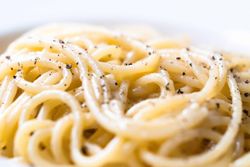
Cacio e Pepe
Ingredients
- 200 g dried pasta such as tonnarelli or spaghetti
- 2 tsp freshly ground black pepper
- 150 g Pecorino Romano
- Salt to taste
Instructions
- Add the cracked pepper to a pan large enough for the cooked pasta and toast for a minute or two over low heat, until fragrant. Set aside and allow to cool while the pasta cooks.
- In a separate pan, cook the pasta in a minimal amount of generously salted water for 2 minutes fewer than the packet instructions, then use tongs to drain the pasta into the pan with the toasted pepper. Reserve the pasta cooking water.
- Cook over low heat and add most of the finely grated Pecorino Romano to the pan. Allow the cheese to melt for 30 seconds or so, without mixing, then stir vigorously. Add a ladleful of pasta cooking water to the pan and continue to stir until the cheese melts and becomes emulsified. Add more of the pasta cooking water if necessary to loosen the sauce.
- Plate and finish with the rest of the Pecorino Romano and a crack of black pepper. Eat immediately.
Notes
- Using toasted pepper brings even more flavour to cacio e pepe.
- It’s advisable to grate the cheese as finely as possible to help it incorporate more smoothly, ultimately helping to prevent the cheese from clumping.
- Importantly, make sure the pan isn’t too hot when adding the cheese, otherwise the cheese proteins will clump and form a film on the bottom of the pan.
- Pecorino Romano is traditional, but Parmigiano Reggiano can be used at a push, if absolutely necessary. Made with sheep’s milk, Pecorino Romano is far sharper, saltier, and more pungent than parmesan.
- Cook the pasta in as little water as possible – this will make it particularly starchy, which is necessary for producing a perfectly creamy sauce.
- With the ingredients lasting for a long time, it’s worth buying more Pecorino Romano than you’ll need for this cacio e pepe recipe as the dish is a perfect store cupboard recipe: quick to cook, using just a few ingredients.
Sausage Pasta (Cheat’s Ragù)
A quick, easy weeknight dinner, this sausage pasta recipe borrows elements from classic Italian ragù, ready to eat in just 40 minutes.
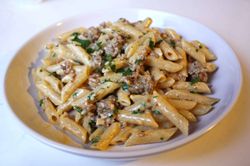
Sausage Pasta
Ingredients
- 600 g Italian sausages* see notes for alternative
- 500 g pasta such as penne or fusilli
- 2 tsp red chilli flakes
- 1 tbsp fennel seeds
- Rapeseed oil or other cooking oil
- 250 ml white wine
- 2 tsp dried oregano
- 1 lemon
- 200 g butter cubed
- Parmesan cheese to taste
- Small bunch flat-leaf parsley chopped
- Sea salt
- Freshly cracked black pepper
Instructions
- Fill a pan with water to cook the pasta, add a good pinch of salt, cover, and bring to the boil.
- In a separate saucepan or large frying pan, add the chilli flakes and fennel seeds and cook over a low heat for a few minutes, shaking or stirring almost constantly to prevent burning. Once the fennel smells strong, quickly remove the chilli and fennel from the pan to a bowl or plate and set aside.
- In the same pan, heat a tablespoon of oil and add the sausage meat. If using sausages, remove the skins before adding to the pan. Cook over medium-high heat, using a masher or wooden spoon to break into small pieces, somewhere between minced meat and small meatballs. Stir occasionally until lightly browned, around 5 minutes. The sausages will stick to the pan a little, but that’s absolutely fine at this point.
- Once lightly browned, add the toasted chilli flakes and fennel seeds to the pan and stir to combine. Cook for another few minutes until the sausage meat is browned, then slowly pour the wine into the pan and keep stirring to deglaze the pan. Decrease the heat to medium-low and continue cooking until the wine has reduced by 2/3.
- From adding the wine to the pan, the rest of the cooking process will take around 10 minutes, so plan accordingly so your pasta is ready at the same time. If the sausage mixture is cooked before the pasta, simply remove from the heat and keep warm.
- Add the pasta to the pan of boiling water and cook according to packet instructions. Dried pasta is fine, but I much prefer fresh pasta, which also cooks far quicker.
- Meanwhile, add the dried oregano to the pan with the sausages and wine, plus the zest and juice of one lemon. Stir and continue cooking on low heat until reduced to an ideal consistency.
- Once the pasta is cooked al dente, drain and reserve the cooking water.
- Add the cooked pasta to the pan with the sausages and stir well to combine, continuing to cook over the lowest heat.
- Quickly add the butter, chopped parsley, parmesan, and a ladleful of the pasta cooking water and keep stirring until well combined and the butter and cheese has melted.
- Serve with an additional handful of grated or shaved parmesan, plus a good crack of black pepper.
Sette’s spaghetti with tomato and basil
Knightsbridge restaurant Sette’s spaghetti with tomato and basil is a particularly popular dish, best incorporated with a large knob of salted butter for extra decadence.

Sette’s spaghetti with tomato and basil
Ingredients
For the fresh spaghetti
- 512 g “OO” flour
- 64 g Semolina
- Salt a pinch
- 5 Egg yolks
- 1 Egg
- 118 ml Water plus 1 tbsp
- 1 tbsp Extra virgin olive oil
Ingredients
- 450 g Spaghetti
- 900 g Roma tomatoes
- 1 Tin San Marzano tomatoes whole peeled
- 2 tsp Sea salt
- 4 cloves Garlic peeled
- 250 ml Extra virgin olive oil
- Chilli flakes a pinch
- 4 Basil leaves
- 1 tbsp Parmigiano Reggiano grated
- 2 Basil leaves chiffonade
Instructions
Method
- Blanch tomatoes and shock in ice water. Remove skin and discard. Deseed the tomatoes and strain the liquid from the seeds. Discard the seeds.
- In a heavy bottom pan, add the fresh tomatoes. Add canned tomatoes and sea salt, cooking over low heat. Using a potato masher, break up the tomatoes and continue cooking, reducing by ¼ for about 1 ½ hours.
- As the tomatoes cook, add garlic, chili flakes and oil to a small pot. Cook the garlic over medium heat until lightly browned. Remove from heat and add basil, allowing the four basil leaves to steep for 15 minutes. Strain the oil into the tomato sauce base, blend and reserve.
- When ready to serve, warm sauce in a sauté pan, bring to a simmer, and add al dente pasta. Cook all together for two minutes. Add grated Parmigiano and chiffonade basil, toss well and serve.
To make the spaghetti
- Using a mixer with the dough hook attachment, add “OO” flour, ¼ plus 2 tbsp semolina and pinch of salt to the bowl.
- Set mixer to speed two to start, and fold egg yolks and egg into the mixture until incorporated, then add in oil and water. Allow dough to mix for 10 minutes or until all ingredients are fully blended and in one uniform dough. Add extra water by the tablespoon if needed.
- Remove from the mixer, and knead the dough with your hands on a floured surface to create one round ball. Place the dough into in a large plastic kitchen bag, kneading the dough to push out any air bubbles. Remove dough from the bag, wrap in plastic wrap, and allow to rest in the refrigerator overnight.
- To roll pasta, cut ½” slices from the chilled dough, and roll by hand on a lightly floured surface to create an elongated piece, then place through roller attachment on the mixer. Fold the dough over and run through the rolling attachment 2-3 more times, finishing on setting number one. Cut the dough into pieces 10” in length.
- Switch to a spaghetti attachment, placing one 10” piece through at a time, gently pulling the spaghetti out on the other side and allowing to rest on a sheet tray. Sprinkle with flour.
- To cook, place pasta in salted, boiling water for 3 minutes. Drain.
- Placed cooked spaghetti in a sauce pan and sauté with your desired sauce for 2 minutes. Serve, and enjoy.
RELATED: How To Make: Aubergine Parmigiana (Melanzane Alla Parmigiana)

